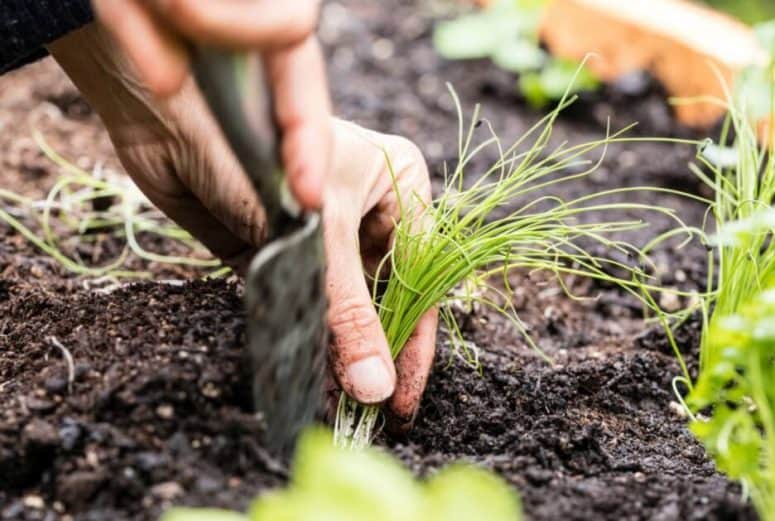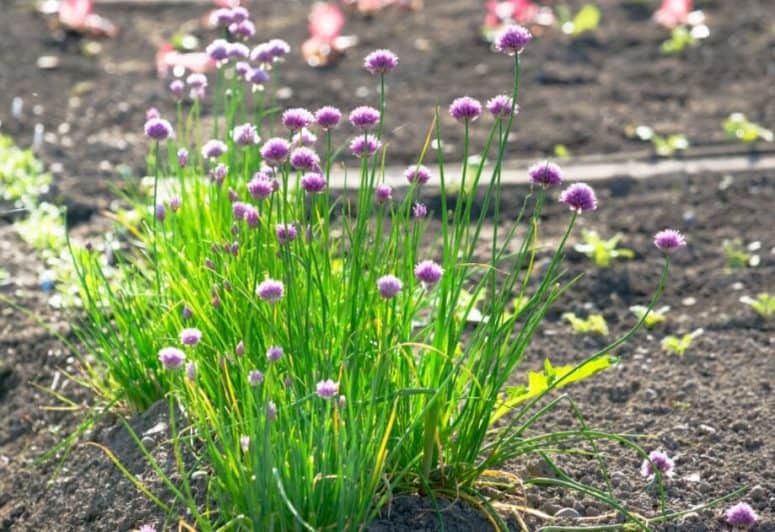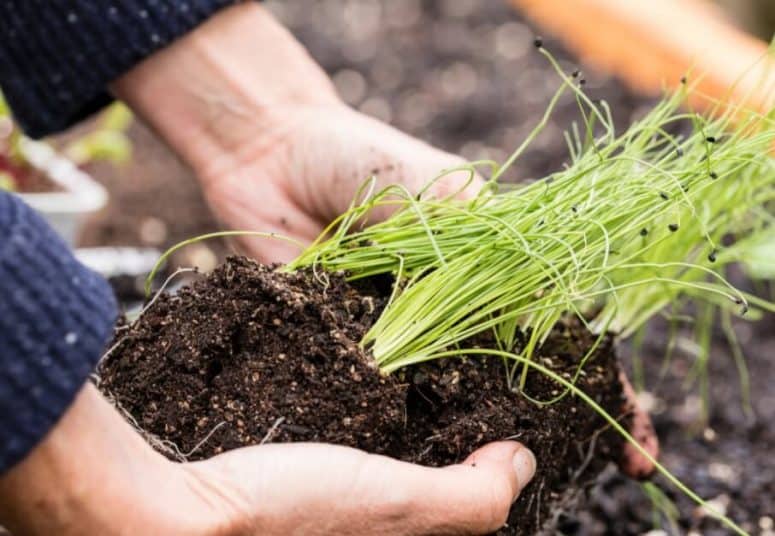How to Grow Chives At Home (A Beginner Guide)

Chives are often seen as spring onions. Thanks to that, chives are one of the most well-known herbs. However, chives and spring onions are different things. Spring onions are more prominent than chives, and they have different flavor strengths as well.
In terms of appearance, chives look similar to onions, with long and light green stems and mildly-pungent flavor. Also, chives do bloom flowers, edible flowers.
There are some different species of chives, and both flowers are edible, either raw or fried. The flowers from chives could be used to infuse vinegar with the delicacy of onion flavor.
Like parsley, chives are also popular as a versatile garnish with a more pungent flavor in comparison. If parsley gives more freshness into the dishes, chives provide a bright, oniony, and somehow spicy flavor to the dish, on the other hand.
For culinary purposes, chives are the right herbs for soup, oil glaze, dressings, or dips, along with some eggs or any dish with potato as its base. The taste of chives could be similar to the combination of onion and garlic as well.
Therefore it is a perfect idea to mix chives into buttery sauce or dishes because it has that aromatic sensation you can usually smell from freshly baked garlic bread.
Since chives are often used or eaten raw and fresh, you cannot do many things to handle chives in the cooking.
Additionally, did you know that chives contain vitamin K, which is useful for increasing bone density and preventing osteoporosis? Also, chives are believed to avoid cancer and improve memory skills.
Having chives grown in your house is going to be one gardening activity you won’t regret. It saves money, and it benefits your cooking. Also, growing Chives won’t be a big issue, even for a green thumb beginner. Chives are one of the easiest herbs to grow. Here is the ultimate guide on how to grow chives at home.
How to Grow Chives
There are two different types of chives, common chives, and garlic chives. Both have minor differences, such as the flowers’ color and the mild garlic taste in garlic chives.
There are two most common ways to grow chives. You can either plant chives from seed or planting them by cuttings. Planting chives from seeds means sowing the seed from the very first step and wait for a couple of time to germinate. The germination process for chives is around 14 days.
Meanwhile, growing it from cutting or planting from existing chives means producing the stem from the previously grown chives plants that are usually available in nurseries or any grade centers.
If you want to have a more comfortable and faster way, you’d better grow chives from cuttings. It is okay to grow parsley from seed, but it might be hard to establish for beginners.
Indoor or Outdoor?
Like most herbs, chives are quite versatile; they can be planted indoors in a container or outdoors in an open garden with 23 to 30 cm space for each plant.
Although chives are adaptable either indoors or outdoor, you still have to pay attention to the soil temperature. The temperature for planting chives indoors and outdoor is different.
As for indoors, you should have 65 to 70 F soil, to begin with. Meanwhile, for outdoors, either for the start or transplantation from indoor, you should have a 50 F temperature on your garden soil.
Soil
Moist and well-drained soil is the soil that chives like the most. The loamy and sandy texture of the soil is going o match better with chives.
Don’t also forget to add organic matter and aged compost for better results. Chives prefer a soil pH of 6.0 to 7.0.
In the last one, the same herb rules applied. You should never overwater the soil unless you want root rot and bulb diseases to appear.
Light
Chives like full-sun exposure. Nevertheless, they can tolerate light shade if you plant it outdoor in your garden.
Planting chives indoors is also okay, as long as you place the container near the window with sunny spit in the house. That shall be okay since chives tolerate light shade.
Water
Speaking of water, chives require moderate watering to be established if you plant them from seeds.
However, chives are tolerant of drought as well. Therefore it is more tolerable for chives to dried out rather than being overwatered. Just keep the soil moist by watering it once you see the soil’s top inches has dried out.
Additionally, you could consider mulching if you are not always into regular watering. This way, you can conserve moisture and prevent bulbs from appearing.
Temperature
Yes, chives can tolerate drought, but the extreme heat in summer could result from dormant chives. On the other hand, a freezing temperature in winter could also kill off the foliage.
Therefore, there so many chives grown in the pot are overwintered.
The best result of planting chives would be in the spring and fall season with enough sunlight and watering.
Fertilizer
As for fertilizer, chives do not require a lot of particular nutrients. With aged compost and organic matter, chives are going to grow just fine.
Harvesting
You can harvest chives after 30 days of transplanting cut ones and 60days of seeding ones. Chives will bloom the flower in the late spring or summer. The flowers are edible, so you can take them and eat them too.
You can cut the stems of chives to the base and do that regularly. This way, you can trigger more leaves to produce.
Fresh chives are often used as soon as they are harvested. You can cut and pack them into ice cube trays with water, though.
Cut the outer leaves first. Harvest from the base of leaves to avoid plants with cut tops. Leave about 2 inches of leaf blade above the soil for the leaves to regrow. Always leave some top growth on the clumps to preserve the strength of the bulbs.
Stop harvest three weeks before the first frost date to allow plants to flower and the clump to expand. Garlic chives can be pulled roots and all.
Troubleshooting the Pest
Aphids are what you need to worry about. Spray your chives with neem or insecticidal soap on the waxy leaves to make sure it contacts the pest.
Other than that, root rot and bulbs are what you need to be aware of. Those could be well handled by having good watering and soil quality.
Conclusion
Chives are a versatile plant that could handle drought but not overwatered. However, extreme heat in summer and cold in sinter could kill chives anyway.
Therefore, regular watering once the top inches of the soil dried out is very much required. Keep the chives in a full-sun and be aware of the pest troubleshooting. That way, you will grow the best chives in your house.


